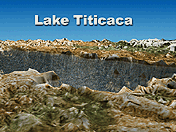

To the Incas it was the legendary birthplace of their civilization - Lake Titicaca, the highest of the earth's large lakes. Crystal-clear, blue as sapphire, the vast, island-dotted South American lake is larger than Delaware and Rhode Island combined, at about 3200 square miles, and sits at a soaring elevation of 12,500 feet, well over two miles above sea level.
 Pleistocene precipitation,
about 20% greater than current levels, created large lakes such as
paleolake "Tauca" shown by pink shading above.
Pleistocene precipitation,
about 20% greater than current levels, created large lakes such as
paleolake "Tauca" shown by pink shading above.Map courtesy: Servant, M., and Fontes, J.C. (1978). Les lac quaternaires des hauts plateaux des andes boliviennes. Premieres interpretations paléoclimatiques. Cahiers O.R.S.T.O.M., Série Géologie 10, 9-23. |
According to legend, the ruins of an underwater city called Wanaku can still be seen in the lake's clear waters. But for a team of NSF-funded scientists, another sort of wonder lies beneath the surface: a virtual data-bank chronicling thousands, even millions, of years of the history of climate of western central Amazonia. In a project partially funded by the Division of International Programs, the scientists are tapping into the lake's deep sediments to extract a record of climate extending, initially, over the past 30,000 years, and perhaps eventually as far back as the Pliocene Epoch, which ended 1.6 million years ago.
The key focus of the project, led by Paul A. Baker of Duke University and Geoffrey O. Seltzer of Syracuse University, is to analyze ancient debris contained in a core of sediment removed from the lake bottom. The scientists use several methods to extract a record of climate from the debris. For instance, the ratio of two isotopes of oxygen (oxygen-16 and oxygen-18) in shells of tiny shrimp called ostracodes varies with water temperature. As the organisms die, their minuscule shells drift down to the lake bottom. Over time, they form a continuous, layered record of shifts in lake temperature, and hence, in the region's climate. (Or possibly not. The isotope ratios tend to shift with changes in precipitation as well as temperature. This complicates any analysis. Fortunately, the Lake Titicaca researchers can rely on recent studies detailing precipitation history on a nearby volcanic mountain, Sajama, which lies only about 60 miles from the lake. On the volcano, the precipitation history lies recorded in cores of ice removed from a glacier). The scientists can link climate to time using radio-carbon dating.
The scientists are not the first to extract and study sediment cores from the lake. But previous coring studies were only able to locate sediments that went back about 3500 years. In some of their initial work, the NSF-funded team determined the reason why. Previous studies had used cores from shallow water around the edges of the lake. By extracting cores from deeper in the lake, the researchers discovered that between 3500 and 9000 years ago the lake level was about 300 feet lower than today. Thus, to obtain a longer record, scientists need to efficiently extract cores from the deeper waters of the lake's central basin. In 1997, the research team launched a specially equipped, 38 foot vessel called the Neecho onto the legendary lake's clear waters, to allow them to do just that.
The effort is one of several being undertaken world-wide to try to reconstruct the history of the earth's climate. It is expected to yield a wealth of new knowledge -- and hardly just about the climate history of Lake Titicaca, or the Altiplano, the high plateau of Peru and Bolivia on which the great lake lies. As the only large lake in the South American tropics, Titicaca and its sediments appears to have functioned as an effective recorder of climate for all of western-central Amazonia. Moreover, the climate in the South American tropics appears to be one of the keys to climate thousands of miles away. Scientists are attempting to discover, for instance, more about how shifts in climate in the South American tropics are linked to patterns of warming or cooling of the Gulf Stream, which are linked, in turn, to patterns of warming or cooling in northern Europe. (Were a change in climate to cause the Gulf Stream to deflect further south, average temperature could fall in England and parts of northern Europe by as much as five or ten degrees Centigrade.)
Additionally, researchers worldwide are building extremely sophisticated computer models intended to simulate global climate changes that could be brought on by an increasing build-up of carbon dioxide and other "greenhouse gases" in the atmosphere. But only by thoroughly understanding past climate shifts can these models be tested and improved. Thus, the data from beneath Lake Titicaca's sapphire waters will become a key piece in a historical climate mosaic that scientists drilling cores from sediments and glaciers world-wide are scrambling to assemble.
|
|





